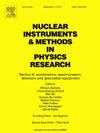从模拟到制造:用氮化硅应力源层图像化实现硅晶体波动器
IF 1.5
3区 物理与天体物理
Q3 INSTRUMENTS & INSTRUMENTATION
Nuclear Instruments & Methods in Physics Research Section A-accelerators Spectrometers Detectors and Associated Equipment
Pub Date : 2025-04-08
DOI:10.1016/j.nima.2025.170480
引用次数: 0
摘要
晶体波动器是一种表现出周期性变形的晶体,这种变形导致通道粒子振荡,产生相干电磁波。在本研究中,应力源层图案化已被用于在硅衬底上诱导所需的变形。通过有限元仿真,优化了波动器的几何参数。主要重点是利用硅(110)平面优越的沟道特性,实现亚毫米周期和振幅超过1nm的正弦变形。关键参数,如衬底厚度和波动周期,都经过精心优化,以确保均匀变形,同时最大限度地减少可能降低性能的高次谐波的影响。在此基础上,成功制备了厚度为160 μm、周期长度为334 μm、周期长度为10个周期的晶体波动体。最终器件结构完整,变形均匀,从表面延伸至20 μm。该波动器专为5-30 GeV粒子束而设计,能够产生5-15 MeV范围内的伽马光子。这项工作有效地将先进的模拟技术与精确的制造方法相结合,证明了晶体波动器作为产生伽马辐射的高性能设备的可行性。本文章由计算机程序翻译,如有差异,请以英文原文为准。
From simulation to fabrication: Realizing silicon crystalline undulators with silicon nitride stressor layer patterning
A crystalline undulator is a crystal exhibiting periodic deformations that cause channeled particles to oscillate, generating coherent electromagnetic waves. In this study, stressor layer patterning has been employed to induce the desired deformations on a silicon substrate. Finite element method simulations were performed to optimize the geometric parameters of the undulator. The primary focus was on achieving sinusoidal deformation with sub-millimeter period and amplitude exceeding 1 nm, utilizing the silicon (110) plane for its superior channeling properties. Key parameters, such as substrate thickness and undulator period, were meticulously refined to ensure uniform deformation while minimizing the impact of higher harmonics, which could degrade performance. Based on the simulation results, a crystalline undulator, 160 thick and consisting of 10 periods with a period length of 334 , has been successfully fabricated. The final device demonstrates structural integrity and a uniform deformation extending up to 20 from the surface. Specifically designed for use with 5–30 GeV particle beams, the undulator is capable of generating gamma photons in the 5–15 MeV range. This work effectively integrates advanced simulation techniques with precise fabrication methods, demonstrating the feasibility of crystalline undulators as high-performance devices for generating gamma radiation.
求助全文
通过发布文献求助,成功后即可免费获取论文全文。
去求助
来源期刊
CiteScore
3.20
自引率
21.40%
发文量
787
审稿时长
1 months
期刊介绍:
Section A of Nuclear Instruments and Methods in Physics Research publishes papers on design, manufacturing and performance of scientific instruments with an emphasis on large scale facilities. This includes the development of particle accelerators, ion sources, beam transport systems and target arrangements as well as the use of secondary phenomena such as synchrotron radiation and free electron lasers. It also includes all types of instrumentation for the detection and spectrometry of radiations from high energy processes and nuclear decays, as well as instrumentation for experiments at nuclear reactors. Specialized electronics for nuclear and other types of spectrometry as well as computerization of measurements and control systems in this area also find their place in the A section.
Theoretical as well as experimental papers are accepted.

 求助内容:
求助内容: 应助结果提醒方式:
应助结果提醒方式:


